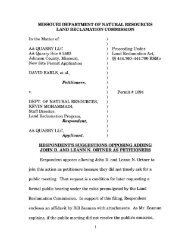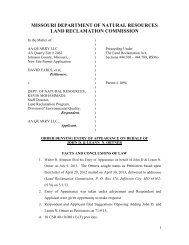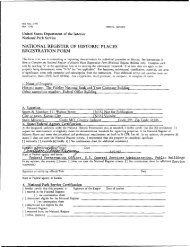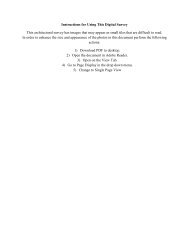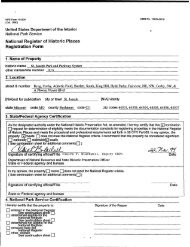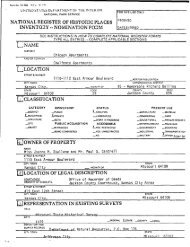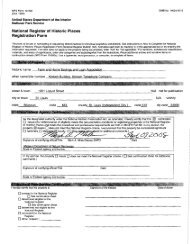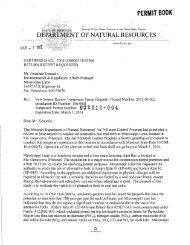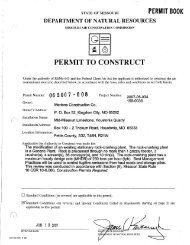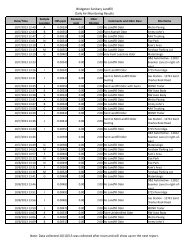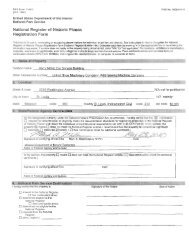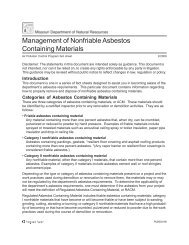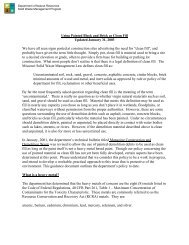EPA approval letter - Missouri Department of Natural Resources
EPA approval letter - Missouri Department of Natural Resources
EPA approval letter - Missouri Department of Natural Resources
Create successful ePaper yourself
Turn your PDF publications into a flip-book with our unique Google optimized e-Paper software.
UNITED STATES ENVIRONMENTAL PROTEC'TION AGENCY<br />
Mr. Scott Totten, Acting Director<br />
Water Protection Program<br />
Water Protection and Soil Conservation Division<br />
<strong>Missouri</strong> <strong>Department</strong> <strong>of</strong> <strong>Natural</strong> <strong>Resources</strong><br />
P. 0. Box 176<br />
Jefferson City, <strong>Missouri</strong> 65 102<br />
Re: Approval <strong>of</strong> Village Creek TMDLs<br />
Dear Mr. Totten:<br />
REGION 7<br />
901 NORTH 5TH STREET<br />
KANSAS CITY, KANSAS 661 01<br />
This <strong>letter</strong> responds to the <strong>Missouri</strong> <strong>Department</strong> <strong>of</strong> <strong>Natural</strong> <strong>Resources</strong> (MDNR)<br />
submission for a Total Maximum Daily Load (TMDL) document which contained TMDLs<br />
for lead and inorganic sediment for Village Creek segments 2863 and 2864. The document was<br />
originally received by the United States Environmental Protection Agency (<strong>EPA</strong>), Region 7, on<br />
September 16,2009. Revisions were made to the original submittal and the final version was<br />
resubmitted on December 7,2009.<br />
Village Creek was identified on the 200412006 <strong>Missouri</strong> Section 303(d) list as impaired.<br />
This submission fulfills the Clean Water Act statutory requirement to develop TMDLs for.<br />
impairments listed on a state's 5 303(d) list. The specific impairment (water body segment and<br />
pollutant) is:<br />
Water Body Name WBID Pollutant<br />
Village Creek<br />
Village Creek<br />
lead and inorganic sediment<br />
lead and inorganic sediment<br />
<strong>EPA</strong> has completed its review <strong>of</strong> the TMDL document with supporting documentation<br />
and information. By this <strong>letter</strong>, <strong>EPA</strong> approves the submitted TMDLs. Enclosed with this <strong>letter</strong><br />
is the <strong>EPA</strong> Region 7 TMDL Decision Document summarizing the rationale for <strong>EPA</strong>'s <strong>approval</strong><br />
<strong>of</strong> these TMDLs. <strong>EPA</strong> believes the separate elements <strong>of</strong> the TMDLs described in the enclosed<br />
form adequately address the pollutants <strong>of</strong> concern, taking into consideration seasonal variation<br />
and a margin <strong>of</strong> safety. Although <strong>EPA</strong> does not approve the monitoring plan submitted by the<br />
state, <strong>EPA</strong> acknowledges the state's efforts. <strong>EPA</strong> understands that the state may use the<br />
monitoring plan to gauge the effectiveness <strong>of</strong> the TMDLs and determine if hture revisions are<br />
necessary or appropriate to meet applicable water quality standards.
<strong>EPA</strong> is currently in consultation under Section 7 <strong>of</strong> the Endangered Species Act with the<br />
United States Fish and Wildlife Service regarding these TMDLs. While we are approving these<br />
TMDLs at the present time, we may decide that changes to the TMDLs are warranted based<br />
upon the results <strong>of</strong> the consultation when it is completed.<br />
We appreciate the thoughtful effort that MDNR has put into these TMDLs. We will<br />
continue to cooperate with and assist, as appropriate, in future efforts by MDNR to develop the<br />
remaining TMDLs.<br />
Enclosures<br />
Sincerely,<br />
cc: Mr. John Hoke<br />
<strong>Missouri</strong> <strong>Department</strong> <strong>of</strong> <strong>Natural</strong> <strong>Resources</strong><br />
Mr. Gerald Babao<br />
American Canoe 'Association<br />
Mr. Paul Sanford<br />
American Canoe Association<br />
Mr. Scott Dye<br />
Sierra Club<br />
Mr. John Sirnpson<br />
KS <strong>Natural</strong> Resource Council<br />
'lliarn A. Spratlin<br />
Water, Wetlands and Pesticides Division<br />
V
TMDL ID: MO-2864<br />
Document Name: -VILLAGE CREEK<br />
<strong>EPA</strong> Region 7 TMDL Review<br />
State: MO<br />
Basin(s): ST. FRANCIS-UPPER ST. FRANCIS RIVER BASIN<br />
HUC(s): 08020202<br />
Water body(ies): VILLAGE CREEK<br />
Tributary(ies): MINE LA MOTTE LAKE, MUSCO CREEK, SHAYS CREEK,<br />
SWEETWATER CREEK<br />
Pohtant(s): INORGANIC SEDIMENT, LEAD (SEDIMENT)<br />
Submittal Date: 911 612009 Approved: yes<br />
Submittal Letter<br />
State submittal <strong>letter</strong> indicates final Total Maximum Daily Load($ (TMDL) for speciJicpollutant(s)lwater(s) were<br />
adopted by the state, and submitted to <strong>EPA</strong> for <strong>approval</strong> under section 303(d) <strong>of</strong> the Clean Water Act [40 CFR §<br />
130.7(c)(l)]. Include date submitted <strong>letter</strong> was received by <strong>EPA</strong>, date <strong>of</strong> receipt <strong>of</strong> any revisions, and the dale <strong>of</strong><br />
original <strong>approval</strong> ifsubmittal is aphase II TMLlL.<br />
The TMDL document for Village Creek was formally submitted by the <strong>Missouri</strong> <strong>Department</strong> <strong>of</strong> <strong>Natural</strong><br />
<strong>Resources</strong> WNR) in a <strong>letter</strong> received by the United States Environmental Protection Agency (<strong>EPA</strong>), Region<br />
7, on September 16,2009. Revisions to the TMDL document were sent by email on 12/07/2009.<br />
Water Quality Standards Attainment ,<br />
The water body's loading capacity (LC) for the applicablepollutant is identiJied and the rationale for the method<br />
used to establish the cause-and-effect relationship between the numeric target and the identiJiedpollutant sources<br />
is described TMDL and associated allocations are set at levels adequate to result in attainment <strong>of</strong> applicable<br />
water quality standards (WQs) [40 CFR § 130.7(c)(l)]. A statement that WQS will be attained is made.
The TMDL document was written to address the impairment <strong>of</strong> lead and inorganic sediment on segments 2863<br />
and 2864 <strong>of</strong> Village Creek, as included on the 200412006 <strong>Missouri</strong> 303(d) list. The inorganic sediment<br />
impairment replaces the 1998 303(d) listing impairment sediment and the 2002 303(d) listing impairment non-<br />
volatile suspended solids. The LCs are determined by load duration curves addressing the chronic dissolved<br />
lead numeric criterion and numeric translators for inorganic sediment, to address the narrative standards.<br />
Sediment:<br />
The water quality targets used in the TMDL for inorganic sediment were developed using a reference approach;<br />
1) A total suspended solids (TSS) target was calculated using the 25th percentile <strong>of</strong> measured concentrations in<br />
streams located in the same region <strong>of</strong> the state, and 2) A percent bedded fine sediment by mass target was set<br />
using a control stream located in the adjacent drainage area. The translation <strong>of</strong> lead and sediment was<br />
accomplished by applying an equilibrium partitioning methodology and a bedded sediment relationship between<br />
mass <strong>of</strong> sediment and mass <strong>of</strong> lead in that sediment with regard to instream lead concentrations. The LC is<br />
determined by a load duration curve addressing the lead numeric criterion and numeric translators for inorganic<br />
sediment to address the narrative standards.<br />
Lead:<br />
Lead follows a defined partitioning behavior between pore water and sediment. The toxicity from lead residues<br />
in water occurs in pore water. When lead resides in sediment it exists in equilibrium with pore water. The<br />
partitioning behavior can then be predicted. Measured lead in sediment was used to estimate pore water<br />
concentrations which are compared to hardness dependent WQS for lead. The Threshold Effect Concentration<br />
(TEC) <strong>of</strong> 35.8 milligrams per kilogram (mgkg) was set as an additional lead target such that the percent <strong>of</strong> lead<br />
in a given mass <strong>of</strong> sediment is below the TEC. A strong statistical correlation exists between total and dissolved<br />
lead concentrations, suggesting that dissolved lead is a good predictor <strong>of</strong> total lead concentration in the water<br />
column. The chronic WQS for dissolved lead had observed exceedances; no acute criteria exceedances were<br />
observed. The TMDL lead endpoint is based on the exceedances <strong>of</strong> the chronk dissolved lead WQS expressed<br />
as a load duration curve using estimated flow values at each outlet.<br />
For segment 2863, the LC at median flow (50 percent flow exceedance), are 0.057 and 109 pounds per day<br />
Obslday) for dissolved lead and inorganic sediment, respectively. For segment 2864, the LC at median flow (50<br />
percent flow exceedance), are 0.034 and 67.8 lbslday for dissolved lead and inorganic sediment, respectively.<br />
'Additional LCs are set for mass per unit mass targets <strong>of</strong> 136 and 0.0358 mgkg <strong>of</strong> fine sediment and lead,<br />
respectively. These mass targets apply for both segments. An additional target was set at the TEC <strong>of</strong><br />
35.8 mgkg, for which the mass <strong>of</strong> lead in a specific mass <strong>of</strong> sediment show toxicity to aquatic organisms.<br />
WQS should be attained when the listed LCs are achieved.<br />
Numeric Target@)<br />
Submittal describes applicable WQS, including beneficial uses, applicable numeric andlor narrative criteria. If<br />
the TMDL is based on a target other than a numeric water quality criterion, then a numeric expression, site<br />
speciJic ifpossible, was developedfrom a narrative criterion and a description <strong>of</strong> the process used to derive the<br />
target is included in the submittal.
The applicable <strong>Missouri</strong> WQS for the inorganic sediment TMDLs are:<br />
10 CSR 20-7.03 l(3)<br />
(A) Waters shall be fiee fiom substances in suflcient amounts to cause the formation <strong>of</strong> putrescent,<br />
unsightly or harmfil bottom deposits or preventfill maintenance <strong>of</strong> beneJicia1 uses;<br />
(C) Waters shall be fiee fiom substances in suflcient amounts to cause unsightly color or turbidity,<br />
<strong>of</strong>ensive odor orpreventfill maintenance <strong>of</strong> beneJicial uses;<br />
(D) Waters shall be Pee Porn substances or conditions in sufJicient amounts to result in toxicity to<br />
human, animal or aquatic lif;<br />
10 CSR 20-7.03 l(4)<br />
(H) Solids. Wuter contaminants sh~ill not cuuse or contribute to solids in excess <strong>of</strong> a level thut will<br />
interfere with beneJicia1 uses. The stream or lake bottom shall befiee <strong>of</strong> materials which will<br />
adver.sely alter the composition <strong>of</strong> the benthos, interfere with the spawning <strong>of</strong>Jish or development <strong>of</strong><br />
their eggs or cihersely change the physical or chemical nature <strong>of</strong> the bottom.<br />
The applicable <strong>Missouri</strong> WQS for the Lead TMDLs are:<br />
10 CSR 20-7.03 1(4)(A)<br />
The maximum chronic toxicity criteria in Tables A and B shall apply to waters designated for the<br />
indicated uses given in Tables G and H. All Table A and B criteria are chronic toxiciv criteria, except<br />
those speciJically identiJied as acute criteria. Water contaminants shall not cause or contribute to<br />
concentrations in excess <strong>of</strong> these values.<br />
10 CSR 20-7.03 1 (4)(B) 1<br />
Water contaminants shall not cause the criteria in Tables A and B to be exceeded Concentrations <strong>of</strong><br />
these substances in bottom sediments or waters shall not harm benthic organisms and shall not<br />
accumulate through the food chain in harmful concentrations, nor shall state and federal mmrimumJish<br />
tissue levels forJish consumption be exceeded<br />
_ The applicable <strong>Missouri</strong> WQS for hardness are:<br />
Hardness<br />
Lead udL<br />
Acute<br />
Chronic<br />
50-74<br />
30<br />
1<br />
75-99<br />
47<br />
2<br />
100-124<br />
65<br />
3<br />
125-149<br />
82<br />
3<br />
The beneficial uses for both segments <strong>of</strong> Village Creek are the same: Livestock Watering, Protection <strong>of</strong><br />
Warmwater Aquatic Life, Protection <strong>of</strong> Human Health (Fish Consumption), and Whole Body Contact<br />
Recreation - Category B.<br />
For segment 2863, the LCs at median flow (50 percent flow exceedance), are 0.057 and 109 lbslday dissolved<br />
lead and inorganic sediment, respectively. For segment 2864, the LC at median flow (50 percent flow<br />
exceedance), are 0.034 and 67.8 lbslday dissolved lead and inorganic sediment, respectively. Additional LCs<br />
are set for mass per unit mass targets <strong>of</strong> 136 and 0.0358 mgKg <strong>of</strong> fine sediment and lead, respectively. An<br />
additional target was set at the TEC <strong>of</strong> 35.8 mglkg.<br />
Pollutant(s) <strong>of</strong> concern<br />
An explanation and anal'ical basis for expressing the TMDL through surrogate measures (e.g., parameters such<br />
as percentJines and turbidity for sediment impairments, or chlorophyl-a andphosphorus loadings for excess<br />
algae) is provided, ifapplicable. For each identiJiedpollutant, the submittal describes analytical basis for<br />
conclusions, allocations and margin <strong>of</strong> s@ev (MOS) that do not exceed the LC. Ifsubmittal is aphase II TMDL<br />
there are reJined relationships linking the load to WQS attainment. Ifthere is an increase in the TMDL there is a<br />
reJined relationship speciJied to validate the increase in TMDL (either load allocation (ZA) or waste load<br />
allocation (WLA)). This section will compare and validate the change in targeted load between the versions.<br />
&<br />
150-174<br />
100<br />
4<br />
175-199<br />
118<br />
5<br />
200-224<br />
136<br />
5<br />
225-249<br />
154<br />
6<br />
250+<br />
172<br />
7
The submittal targets an established link between TSS and percent fine bottom sediment to address the<br />
narrative impairment <strong>of</strong> inorganic sediment. The TSS target is calculated fiom the 25th percentile <strong>of</strong> all available<br />
data located within the ecological drainage unit in which the water body is located. The lead sediment target was<br />
set using the percent <strong>of</strong> lead in a given mass <strong>of</strong> sediment such that the TEC is below the target level. The<br />
inorganic sediment target is also represented by calculating the percent fine sediment by mass. These targets are<br />
appropriate, as the region in which the impaired stream segments exist is not typically a source <strong>of</strong> sediment,<br />
either organic or inorganic, to the streams that drain through that area. As an additional MOS a bed sediment<br />
target <strong>of</strong> percent fine sediments is set equal to that <strong>of</strong> a nearby control stream.<br />
The lead targets were established linking total lead to the dissolved lead criterion fiom the approved <strong>Missouri</strong><br />
WQS. An analysis <strong>of</strong> the relationship <strong>of</strong> total to dissolved lead concentrations shows a strong statistical<br />
correlation and suggests that dissolved lead concentration is a good predictor <strong>of</strong> total lead concentration in the<br />
water column. Measured lead in sediment data were used to calculate pore water concentration based on<br />
partitioning coefficients <strong>of</strong> sediment lead in water. The partitioning coefficient allows a range <strong>of</strong> concentrations<br />
in pore water with a given concentration in sediment to be calculated. This resulted in an additional lead target<br />
for the threshold effect concentration <strong>of</strong> lead in sediment. This is not a numeric criterion in the approved<br />
<strong>Missouri</strong> WQS but serves as an additional target to address narrative criteria protecting benthic invertebrate life.<br />
Source Analysis<br />
Important assumptions made in developing the TMDL, such as assumed distribution <strong>of</strong> land use in the watershed,<br />
population characteristics, wildlife resources, and other relevant information affecting the characterization <strong>of</strong> the<br />
pollutant <strong>of</strong> concern and its allocation to sources, are described. Point, nonpoint and background sources <strong>of</strong><br />
pollutants <strong>of</strong> concern are described, including magnitude and location <strong>of</strong> the sources. Submittal demonstrates all<br />
significant sources have been considered. Ifthis is aphase II TMDL any new sources or removedsources will be<br />
speciJied and explained<br />
I<br />
This watershed is located within Operable Unit-0 1 <strong>of</strong> the Superfund site known as Madison County Mines. The<br />
designation occurred in 2003 and is being evaluated.<br />
The submittal states there are no permitted point sources in the watershed <strong>of</strong> either segment that would serve as a<br />
source for either lead or inorganic sediment. The point source for both pollutants is identified primarily the<br />
abandoned Mine La Motte tailings area. The tailings area cove6 approximately 495 acres and is part <strong>of</strong> a<br />
privately owned recreational area with around 250 acres covered by tailings. This area contains a 100-acre<br />
recreational pond as well as a playground, camping sites, and <strong>of</strong>f-road recreational areas. . .<br />
The submittal recognizes the possibility <strong>of</strong> nonpoint source loading <strong>of</strong> lead and inorganic sediment fiom run<strong>of</strong>f<br />
due to haul and access roads, highways, and parking lots. This run<strong>of</strong>f may contain automotive sources <strong>of</strong> lead<br />
(e.g., tire residues, exhaust fumes, battery fluid, and motor oil). Urban and impervious land uses occupy 1.8<br />
percent in segment 2863, and 3.8 percent in segment 2864, <strong>of</strong> the total watershed areas. Undisturbed areas <strong>of</strong> the<br />
watershed are expected to only contribute minor amounts <strong>of</strong> inorganic sediment and dissolved lead.<br />
There are no state-permitted concentrated animal feeding operations, or CAFOs, in the watershed, the likely<br />
presence <strong>of</strong> lower density livestock populations on grassland pastures may also be a potential contributor <strong>of</strong><br />
inorganic sediment to Village Creek. Livestock influences are expected to be minor when compared to<br />
contributions fiom the Mine La Motte abandoned mine land tailings pile.<br />
It appears all known sources have been included.<br />
Allocation - Loading Capacity<br />
Submittal identifies appropriate WLA for point, and load allocations for nonpoint sources. Ifno point sources are<br />
present the WLA is stated as zero. Ifno nonpoint sources are present, the LA is statedas zero [40 CFR 5 130.2 ,<br />
(91. Ifthis is aphase II TMDL the change in LC will be documented in this section<br />
The submittal provides LC, WLA, LA, and MOS for each pollutant and each segment covered by this TMDL<br />
document. Load duration curves and mass per unit mass targets were used to express the TMDL for dissolved<br />
lead and inorganic sediment.<br />
WLA Comment<br />
Submittal lists individual WLAs for each identifiedpoint source [40 CFR $130.2(71)]. Ifa WLA is not assigned it
must be shown that the discharge does not cause or contribute to WQS excursions, the source is contained in a<br />
general permit addressed by the TMDL, or extenuating circumstances exist which prevent assignment <strong>of</strong> individual<br />
WLAs. Any such exceptions must be explained to a satisfactoy degree. If a WLA <strong>of</strong> zero is assigned to any facility<br />
it must be stated as such [40 CFR J 130.2(i)]. Ifthis is aphase LI TMDL any dzferences in phase I andphase 11<br />
WLAs will be documented in this section.<br />
At median flow (50 percent flow exc'eedance), the WLA is equal to 0.034 and 0.057 lbslday <strong>of</strong> dissolved lead for<br />
segments 2864 and 2863, respectively.<br />
At median flow (50 percent flow exceedance), the WLA is equal to 6 1 and 98.1 lbslday <strong>of</strong> suspended<br />
sediment for segments 2864 and 2863, respectively.<br />
A calculated WLA does not authorize a discharge from an unpermitted point source. However, WLAs may be<br />
used to improve water quality during future remedial actions, and be incorporated into appropriate enforceable<br />
documents (e.g., National Pollutant Discharge Elimination System permits, Applicable Relevant and Appropriate<br />
Requirements, stom water permits, etc.).<br />
LA Comment<br />
Includes all nonpoint sources loah, natural background, andpotential for future growth. Ifno nonpoint sources<br />
are identijied the LA must be given as zero [40 CFR J 130.2(d]. Ifthis is a phase 11 TMDL any dflerences in<br />
phase I andphase 11 LAs will be documented in this section<br />
Because there are negligible and minor nonpoint source loading, LAs <strong>of</strong> zero are set for both dissolved lead and<br />
inorganic sediment (0 lbslday dissolved lead and 0 lbslday inorganic sediment), for both segments.<br />
Margin <strong>of</strong> Safety<br />
Submittal describes explicit andlor implicit MOS for eachpollutant [40 CFR J 130.7(c)(I)]. gthe MOS is<br />
implicit, the conservative assumptions in the analysis for the MOS are described Ifthe MOS is explicit, the<br />
loadings set aside for the MOS are identijied and a rationale for selecting the vaIue for the MOS is provided If<br />
this is aphase 11 TMDL any dzj5erences in MOS will be documented in this section.<br />
The MOS for lead is implicit. The chronic lead criterion is applied to the pore water as well as the water<br />
column, in addition, the threshold effect concentration is also set as a target. The conservative assumptions and<br />
factors used in this method should account for any uncertainties in the loading calculations.<br />
The MOS for inorganic sediment is both implicit and explicit. The conservative assumptions and factors used<br />
when developing the percent fines target, using a control stream in addition to the reference 25th percentile <strong>of</strong><br />
TSS concentrations in the region, provides an implicit MOS. Additionally, the submittal provides a 10 percent<br />
explicit MOS to account for any uncertainties in the setting <strong>of</strong> numeric targets to address a narrative standard.<br />
At median flow (50 percent flow exceedance), this 10 percent MOS is equal to 6.8 and 10.9 lbslday <strong>of</strong> inorganic<br />
sediment for segments 2864 and 2863, respectively.<br />
Seasonal Variation and Critical Conditions<br />
Submittal describes the methodfor accounting for seasonal variation and critical conditions in the TMDL(s) [40<br />
CFR J 130.7(c)(I)]. Critical conditions are factors such as flow or temperature which may lead to the excursion<br />
<strong>of</strong> WQS Ifthis is aphase 11 TMDL any di&erences in conditions will be documented in this section.<br />
The load duration curve represents the maximum one-day load the water body can assimilate and maintain<br />
the water quality criterion, while the given mass <strong>of</strong> lead per mass <strong>of</strong> sediment is instantaneous and applies on<br />
any day in which the content in bed sediment is measured. The use <strong>of</strong> mass per unit mass and load duration<br />
curves apply during all times and account for seasonal and flow variations.<br />
The use <strong>of</strong> pore water target concentrations addresses the critical condition and protects the benthic invertebrate<br />
aquatic life living in close contact with pore water. This target addresses conditions <strong>of</strong> low flow when water<br />
column concentrations <strong>of</strong> lead are likely to be higher due to less dilution <strong>of</strong> pore water loading into the water<br />
column.
Public Participation<br />
Submittal describes requiredpublic notice and public comment opportunity, and explains how the public<br />
comments were considered in the final TMDL(s) [40 CFR § 130.7(c)(l)(ii)].<br />
This document was placed on public notice and posted on the MDNR website from July 27,2009 and<br />
comments were accepted through August 26,2009. MDNR received three comments on the draft TMDL<br />
document. The comments and MDNR's response <strong>letter</strong>s are included in the submission <strong>of</strong> the TMDL document.<br />
Monitoring Plan for TMDL(s) Under Phased Approach<br />
The TMDL identifies a monitoringplan that describes the additional data to be collected to determine ifthe load<br />
reductions required by the TMDL lead to attainment <strong>of</strong> WQS, and a schedule for considering revisions to the<br />
TMDL(s) (where phased approach is used) [40 CFR § 130.71.<br />
Monitoring was completed in May 2008. MDNR will review data collected through the <strong>Missouri</strong> <strong>Department</strong> <strong>of</strong><br />
Conservations' Resource Assessment and Monitoring program which samples physical and biological<br />
components <strong>of</strong> randomly selected streams on a five to six year rotating schedule.<br />
Reasonable Assurance<br />
Reasonable assurance only applies when less stringent WLAs are assigned based on the assumption <strong>of</strong>nonpoint<br />
source reductions in the LA will be met [40 CFR § 130.2(i)]. This section can also contain statements made by the<br />
state concerning the state's authority to control pollutant loadr.<br />
Increased reductions in nonpoint source loads are not being required in lieu <strong>of</strong> less stringent WLAs so<br />
reasonable assurances are not required.. The LA is set at zero.<br />
I<br />
I<br />
I<br />
I



